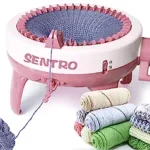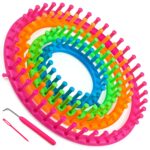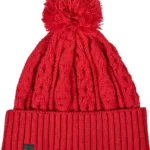Imagine you've picked up your knitting needles, ready to tackle a new pattern. As you read through the instructions, you encounter a cryptic abbreviation: "kfb." Your eyebrows furrow, and you start to wonder if it stands for "knitting for beginners" or "knit freakishly fast" – two things you definitely need help with!
Feeling a little perplexed, you decide to take a wild guess and attempt the "knit fluffier bunnies" technique – hey, it sounds cute, right? But as you knit, your project starts to resemble a fuzzy mess, far from the adorable bunnies you imagined.
In a moment of enlightenment, you reach out to a seasoned knitting friend for help. They chuckle at your creative interpretation of "kfb" and kindly explain that it actually means "knit front and back." Oh, so that's the secret to those neat increases! You can't help but laugh at your bunny-inspired blunder and vow to unravel your fluffy disaster.
Armed with newfound knowledge and a better understanding of knitting abbreviations, you reattempt "kfb" – this time, with great success. As you see your stitches grow and your knitting take shape, you can't help but be grateful for the humor in your knitting journey. After all, making a few fluffy bunnies along the way is all part of the knitter's adventure!
What Does KFB Mean in Knitting: Understanding the Versatile Increase Stitch
If you're a knitting enthusiast, you've likely come across various abbreviations and symbols in knitting patterns that can be both confusing and intriguing. One such abbreviation that often leaves knitters scratching their heads is "KFB." Fear not, fellow knitters, as we unravel the mystery of this knitting jargon and delve into the world of "knit front and back" (KFB).
What is KFB in Knitting?
KFB stands for "knit front and back," and it is a common knitting increase technique used to add stitches to your work. When you encounter KFB in a knitting pattern, it means you need to create a new stitch by knitting into the same stitch twice – once through the front loop and then through the back loop.
Why Use KFB?
The KFB increase creates a neat, almost invisible, and seamless way to add stitches to your knitting project. This increase is often used when shaping a garment, creating raglan sleeves, or forming decorative patterns like lace or cables. The resulting stitches blend seamlessly into the fabric, making it difficult to distinguish them from the existing stitches.
How to Knit Front and Back (KFB) - Step-by-Step Instructions
Step 1: Knitting into the Front Loop (K)
- Insert the right needle into the front loop of the stitch on the left needle, just as you would for a regular knit stitch.
- Wrap the working yarn around the right needle from back to front in a counterclockwise direction.
- Pull the yarn through the front loop to create a new stitch on the right needle, leaving the original stitch on the left needle.
Step 2: Knitting into the Back Loop (K)
- Without slipping the original stitch off the left needle, insert the right needle into the back loop of the same stitch.
- Wrap the working yarn around the right needle from back to front in a counterclockwise direction.
- Pull the yarn through the back loop to create a second new stitch on the right needle.
Step 3: Completing the KFB Increase
- You now have three stitches on your right needle – the original stitch and the two new stitches.
- Carefully slide the original stitch off the left needle.
- The KFB increase is complete, and you have successfully added one stitch to your knitting project.
Tips for Perfecting KFB
Mastering the KFB increase may take a little practice, but with some tips and tricks, you'll be creating seamless increases in no time:
- Consistent Tension: Ensure that you maintain a consistent tension while knitting both the front and back loops to avoid loose or tight stitches.
- Stitch Orientation: Pay attention to the orientation of your stitches. The "V" shape of the stitch should face toward the right side of your work.
- Experiment with Tension: If you find that the added stitches are too tight, try wrapping the yarn a little looser during the KFB increase.
- Practice on a Swatch: Before using KFB in your actual project, knit a swatch to practice the increase and familiarize yourself with the technique.
Variations of KFB
While the standard KFB increase is widely used, there are a few variations that can produce slightly different results:
- KFB in the Purl Stitch: To create a KFB increase when working in the purl stitch, follow the same steps as above, but purl into the front and back loops of the stitch instead of knitting.
- Bar Increase: Some patterns may refer to a "bar increase," which is essentially the same as KFB. It involves knitting into the front and back loops of the stitch to create an increase.
VI. Using KFB in Knitting Projects
The versatility of KFB makes it a valuable increase stitch in various knitting projects:
- Shaping Garments: KFB is often used in garment construction to create gradual or sudden increases in stitch count, shaping the fabric to form sleeves, necklines, and waistlines.
- Decorative Elements: In lace knitting, KFB can be used to add stitches that form eyelets and intricate lace patterns.
- Raglan Sleeves: KFB is frequently employed in raglan sleeve construction to add stitches at the corners, creating a seamless transition between body and sleeves.
- Cable Knitting: In cable knitting, KFB can be used to add stitches to the fabric, allowing the cables to shift and twist elegantly.
Common Mistakes with KFB
As with any knitting technique, mistakes can happen. Some common issues when working KFB include:
- Twisted Stitches: Make sure you insert the needle correctly into both the front and back loops of the stitch to avoid twisted stitches.
- Uneven Tension: Keep an eye on your tension while working the KFB increase to maintain a consistent gauge.
- Skipping the Back Loop: Double-check that you knit into both the front and back loops of the stitch to create two new stitches.
Conclusion
Understanding what KFB means in knitting opens up a world of possibilities for shaping and decorating your knitting projects. Whether you're working on garments, lace, or cable knitting, the KFB increase is a valuable skill to add to your knitting repertoire. With a bit of practice and attention to detail, you'll master this versatile increase stitch, creating beautifully shaped and intricately patterned knitwear with ease. Embrace the art of KFB and let it take your knitting to new heights of creativity and finesse! Happy knitting!
To find out more about knitting, please visit any of the following areas:
- How to sew together knitting
- What is brioche knitting
- How to join yarn in knitting
- How to join in the round knitting
- How to finish a knitting scarf
- How to make a slip knot for knitting
- How to switch colors knitting
- How to hold yarn when knitting
- What does kfb mean in knitting
- How to fix a dropped stitch in knitting
- How to hold knitting needles
- What is frogging in knitting?
- How to change colors in knitting
- How to count rows in knitting
- How to increase in knitting
- How to slip stitch knitting
- How to yarn over in knitting
- What is a knitting loom?
- How to make bobbles in knitting?
- Where can I buy sentro knitting machine?
- What can you make with a sentro knitting machine?
- Cricut Hat Press: A Comprehensive Guide on Usage - August 13, 2023
- Unlocking Creativity with the Cricut Joy: A Comprehensive Guide - August 12, 2023
- The Ultimate Guide to the Cricut Maker Bundle - August 11, 2023





